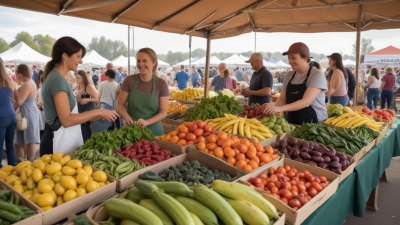How Seasonal Shifts Turn Farmers’ Markets Into Emotional Rollercoasters
Explore the emotional journey of farmers' markets through the seasons and their impact on farmers and consumers.

This image was created with the assistance of Freepik
Farmers' markets are more than just places to buy fresh produce; they are vibrant community hubs where agricultural diversity meets emotional engagement. Each season brings distinct changes that affect the availability of produce, the moods of vendors and consumers, and the overall atmosphere of the market. Understanding these seasonal shifts helps us appreciate the emotional rollercoasters that both farmers and shoppers experience as they navigate the ever-changing landscape of local agriculture.
Spring Awakening: The Hopeful Start
As winter recedes and spring emerges, farmers' markets undergo a transformation. The anticipation of the first market day creates a palpable buzz within communities. Vendors prepare their stalls, often filled with vibrant greens and the first signs of colorful blooms. This season symbolizes renewal and hope, both for the farmers who have toiled through harsh winters and for consumers eager to reconnect with local food sources.
The emotional atmosphere is one of optimism; long-dormant friendships rekindle among vendors and loyal customers alike. The discussions turn to what’s sprouting, how the weather is impacting crops, and the expectations for the upcoming season. However, this hope can also carry an undercurrent of anxiety, as farmers face the fear of late frosts that could jeopardize their nascent crops. This dichotomy of hope and fear encapsulates the early market experience.
Summer Abundance: The Joy of Harvest
With summer arrives a bounty of produce, and the emotional tone shifts to one of exuberance and joy. Vendors proudly display their harvests: juicy tomatoes, crisp cucumbers, and delightful berries. The market transforms into a sensory feast, with vibrant colors, enticing smells, and the sounds of laughter and chatter filling the air. It’s a celebration of abundance that brings communities together.
During the summer months, the market is often at its most lively. Customers flood in, children laugh and play, and there’s a sense of camaraderie among attendees. Seasonal festivals and events often accompany the markets, enhancing social interaction and building community pride. Yet, amidst the joy, farmers face the pressure of managing their crops’ ripening schedules and their competition with rivals. The emotional rollercoaster includes the joy of selling out of produce and the heartache of battling pests and disease that threaten their hard work.
Fall Flavors: The Bittersweet Farewell
As the vibrant tones of summer yield to the warm hues of fall, the farmers' markets take on a bittersweet ambiance. The harvest is in full swing, yet there hangs a melancholy in the air as vendors know that winter is just around the corner. Autumn is a time for celebration, but it also signifies the end of a growing season—a reality that farmers and consumers alike must face.
Markets are filled with the earthy scents of squash, pumpkins, and hearty greens. Consumers indulge in the flavors of fall while also sensing the finality of the season. Vendors reflect on their achievements and challenges, sharing stories that range from the joy of abundance to the trials of a particularly hard-fought growing season. This reflective atmosphere reinforces the bond between the farmers and their patrons, deepening the emotional connection to the food and the people who provide it.
Winter's Hibernation: The Deep Freeze
With the arrival of winter, the farmers' market landscape changes drastically. Many outdoor markets close, leaving behind a void in community interaction. However, some markets transition to indoor venues, showcasing root vegetables, canned goods, and other seasonal offerings. This shift can evoke feelings of isolation among both vendors and consumers. Winter symbolizes dormancy, and the emotion tied to the absence of fresh, locally-grown produce can lead to a sense of longing for the vibrancy of the previous seasons.
Farmers must adapt to survive. Some offer winter shares or subscription services, allowing people to maintain connections with their food sources. Inside these intimate winter markets, emotional resilience becomes key. There’s a certain camaraderie among patrons who brave the cold to support their local farmers. The conversation often turns toward hopes for the upcoming spring—what crops will be planted, and what the future holds—creating an emotional bridge from the past season to the next.
The Cycle of Life: The Interplay of the Seasons
Understanding the emotional implications of seasonal shifts at farmers' markets also emphasizes the interconnectedness of life cycles. As farmers navigate their own emotional journeys throughout the year, consumers experience parallel feelings. The sense of loss, renewal, joy, and hope intertwines the relationships between farmers and their patrons.
Regional and cultural factors also play significant roles in how different markets experience these seasonal emotional swings. For instance, a coastal market may have a different rhythm compared to a highland one. The varieties of produce available can dictate the kind of emotional experiences vendors and customers share, as well as how markets are celebrated.
The Community Connection: Building Relationships
At the heart of this emotional rollercoaster are the relationships built between the farmers and their communities. Each season provides a new opportunity for connection, reflection, and shared experiences. Customers learn about the challenges faced by farmers and discover new products that excite their palates. Additionally, these markets also foster a space where relationships deepen—even friendships can blossom from shared interests in sustainable farming and local food.
As vendors share their stories, customers become invested in their journeys—this strengthens community ties and adds a layer of emotional depth to the market experience. People aren’t just buying food; they are buying into a lifestyle and supporting a way of life that values hard work, sustainability, and local craftsmanship.
Embracing the Emotional Journey
In conclusion, farmers' markets represent a dynamic emotional journey shaped by the seasons. Each phase of the year encapsulates a different set of feelings and experiences for farmers and consumers alike, creating a shared history that enhances the community fabric. By embracing the emotional rollercoaster that comes with seasonal shifts, we not only foster connections with local agriculture but also with each other. As we engage with our local markets, we deepen our appreciation for the labor that goes into our food and the resilience of those who produce it. As the seasons continue to rise and fall, the emotional impact of farmers' markets remains a constant reminder of the cycles of life and the joy found in community.











